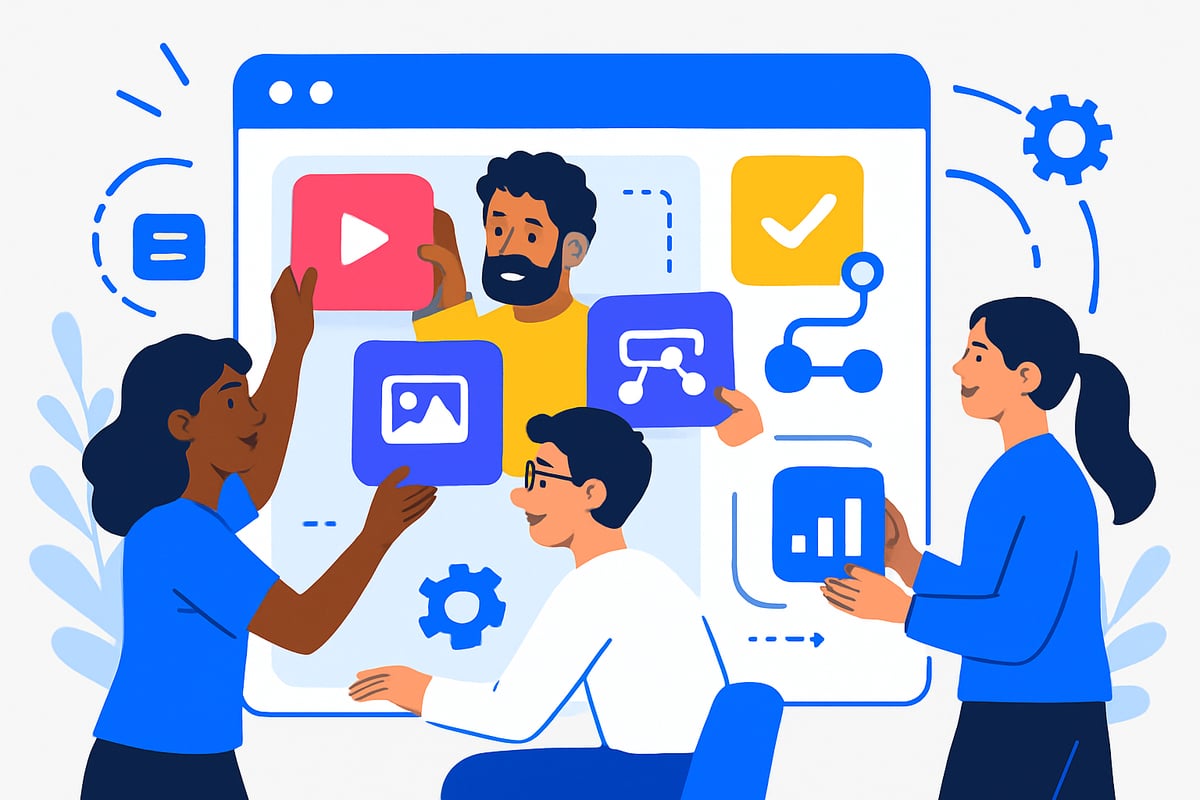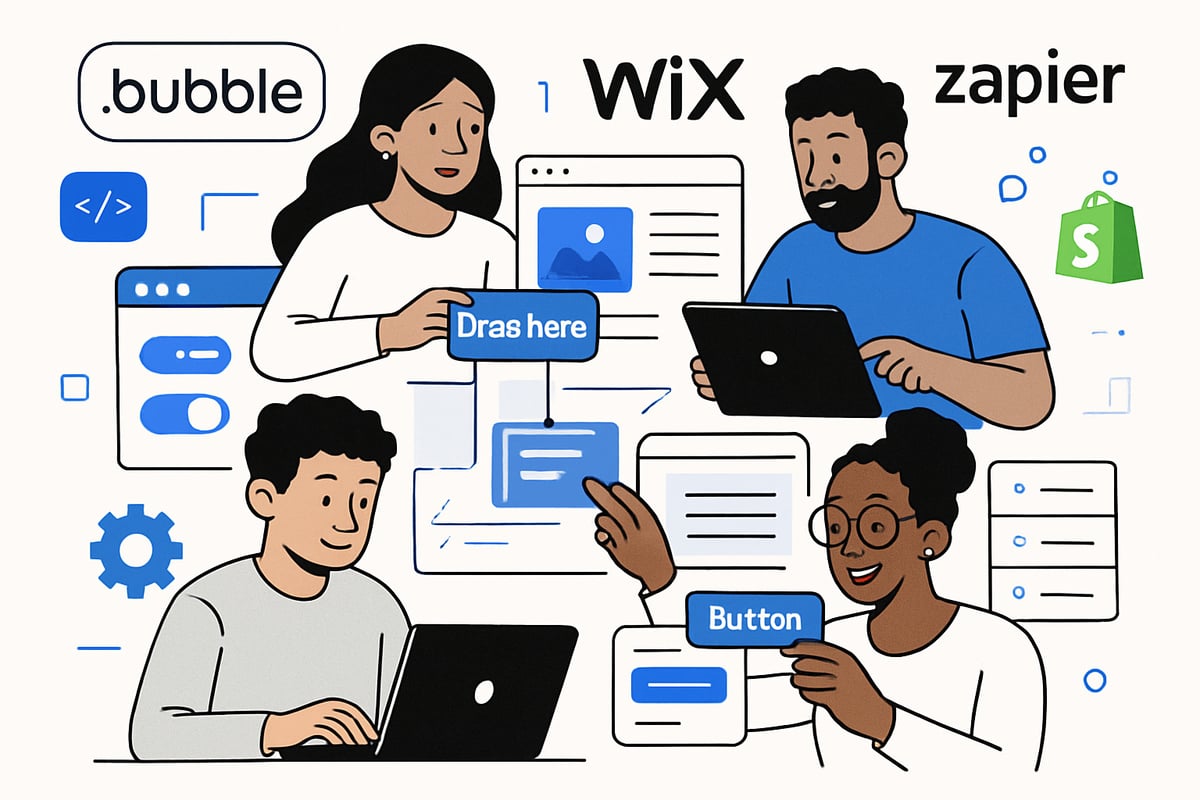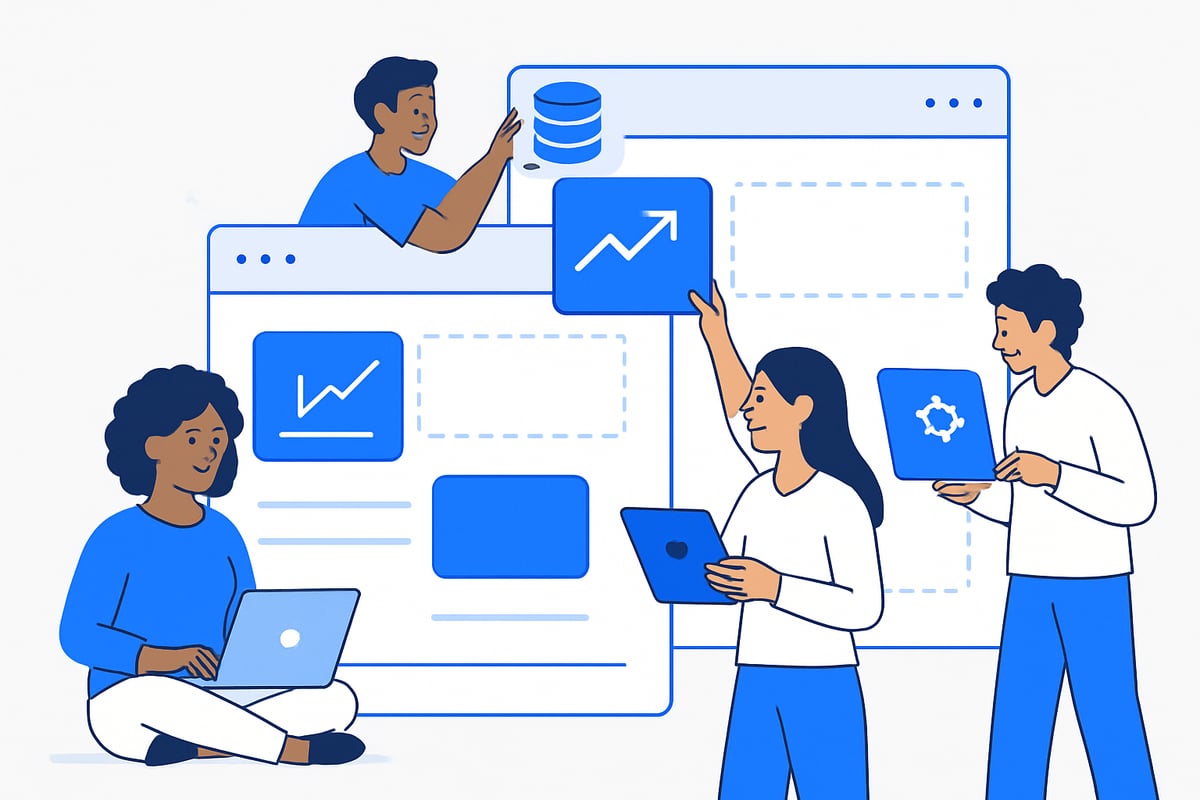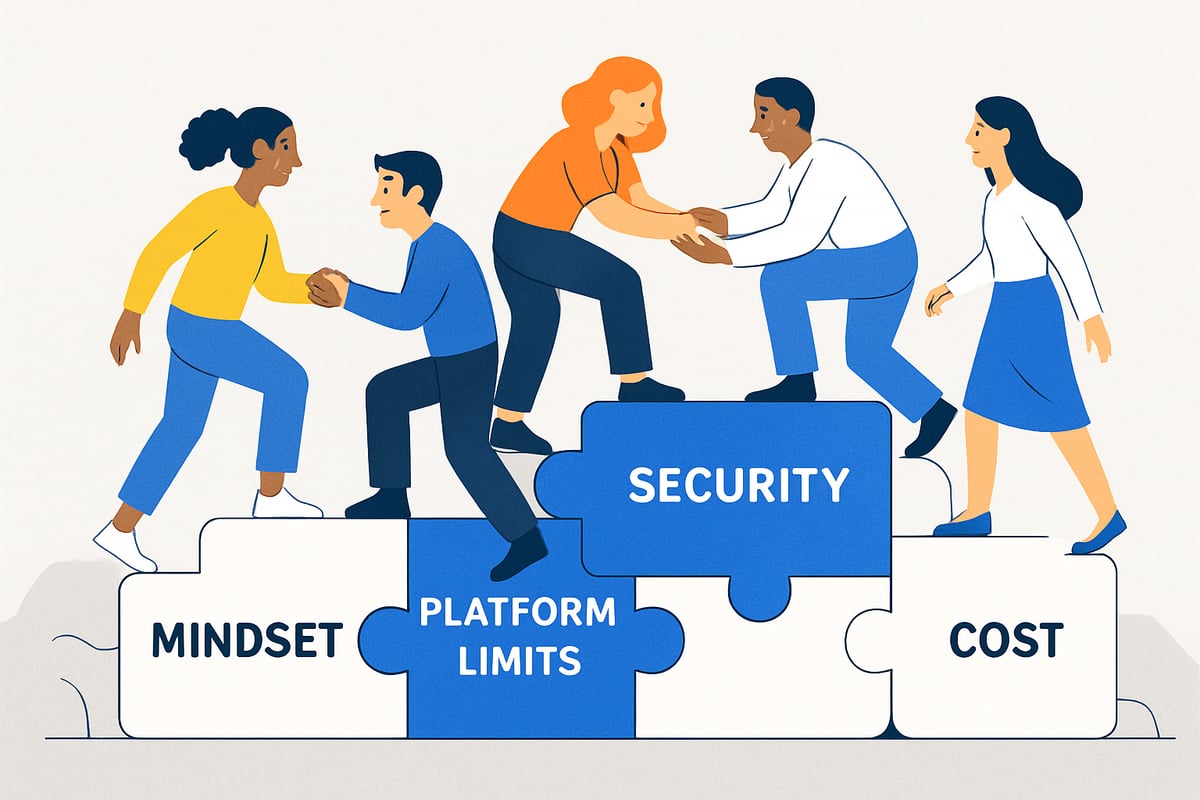Imagine bringing your app ideas to life, automating daily routines, or launching a business, all without touching a single line of code. The world of no coding is opening doors for beginners everywhere, making digital creation more accessible than ever.
This guide is your roadmap to understanding the no-code movement in 2025. Whether you want to build, automate, or innovate, you will find practical steps, essential tools, and fresh mindsets to get started.
Explore what no-code means, discover its benefits, compare top platforms, and follow a step-by-step path designed for beginners. Along the way, you’ll see real success stories and future trends that can inspire your journey.
Ready to unlock your digital potential? Let’s dive in.
Understanding No-Code: What It Is and Why It Matters
Imagine building a website, app, or automating a workflow without touching a single line of code. That's the magic behind no coding. If you're new to the idea, it might sound too good to be true. But the world of no coding is all about making digital creation accessible to everyone. Let's break down what this means, why it's growing, and how you can benefit.

Defining No-Code: Breaking Down the Concept
No coding platforms let you build digital solutions visually, using drag-and-drop editors and pre-built logic blocks. Unlike traditional programming, where you write in languages like HTML, JavaScript, or Python, no coding relies on intuitive interfaces anyone can use.
A common misconception is that no coding equals low quality or lack of customization. In reality, modern no coding tools are robust and scalable. They open doors for non-technical users to create, automate, and innovate quickly. For a deeper dive into this concept, check out No-Code Development Explained.
| Traditional Coding | No Coding |
|---|---|
| Requires programming skills | Visual, drag-and-drop |
| Steep learning curve | Beginner-friendly |
| Time-consuming | Rapid development |
The Rise of No-Code: Market Growth and Trends
The no coding movement is booming. According to Gartner, by 2025, 70% of new apps will be built using no-code or low-code tools. This explosive growth is fueling a wave of digital democratization, where anyone—not just engineers—can build and launch solutions.
Startups, small businesses, and large enterprises are all embracing no coding to innovate faster and respond to market changes. As the technology matures, its adoption is expanding across industries, making it a core part of digital transformation strategies.
Benefits of No-Code for Beginners
No coding offers a range of advantages, especially for beginners. Here are some key benefits:
- Rapid prototyping and faster time to market
- Lower costs, since you don't need to hire developers
- Minimal learning curve for those new to tech
- Empowerment for entrepreneurs, creators, and professionals
With no coding, you can turn ideas into reality quickly, experiment without risk, and focus on solving real problems instead of wrestling with syntax.
Use Cases: What Can You Build Without Coding?
The possibilities with no coding are vast. You can create:
- Web and mobile apps for your portfolio or business
- E-commerce stores with integrated payments
- Internal tools for managing projects or inventory
- Automation workflows to handle repetitive tasks (think Zapier or Make)
Real-world examples include personal portfolio sites, booking platforms for small businesses, and inventory management systems—all built without writing code.
Limitations and Considerations
While no coding is powerful, it does have limitations. Some platforms may have constraints around customization or scalability. For complex or highly specific needs, you might eventually need to add custom code or use APIs.
Security and data privacy are also important to consider. Always review your chosen platform's security features and data policies. As you grow, think about how your no coding solution will scale and whether you'll need to migrate or integrate with other tools.
Essential No-Code Platforms and Tools for 2025
The no coding movement is transforming how people create, automate, and launch digital projects. In 2025, a wide range of platforms make it possible to build everything from apps to entire businesses, all without traditional programming. Let’s explore the top tools and see how they fit different needs and skill levels.

Top No-Code App Builders
When it comes to no coding solutions for apps, three standout platforms lead the way: Bubble, Adalo, and Glide.
- Bubble is ideal for building complex web applications, offering powerful logic and database features.
- Adalo focuses on mobile app creation, making it simple to launch iOS and Android apps with visual editors.
- Glide transforms spreadsheets into sleek apps, perfect for internal tools or lightweight products.
Pricing models vary, with free tiers and scalable paid options. These platforms let you prototype and release products quickly. No coding is needed to design user interfaces, set up workflows, or connect data sources.
Website and E-Commerce Builders
For those looking to create websites or online stores, no coding tools like Wix, Webflow, and Shopify dominate the scene.
- Wix offers drag-and-drop design and hundreds of templates.
- Webflow gives you more design control and animation features.
- Shopify specializes in e-commerce, with integrated payments and inventory management.
With these platforms, you can launch a polished website or store in hours. Responsive layouts ensure your site looks great on any device. No coding knowledge is required to add products, accept payments, or customize your storefront.
Automation and Workflow Tools
No coding is not just for building apps, it also powers automation. Zapier and Make (formerly Integromat) are the go-to platforms for connecting your favorite apps and automating tasks.
- Zapier lets you set up "Zaps" to move data between apps, like auto-saving email attachments to Google Drive.
- Make offers more advanced logic and multi-step workflows.
Example: Automate lead capture by connecting a website form to your CRM and sending instant email follow-ups. These tools remove repetitive work, giving you more time to focus on growth.
AI-Powered No-Code Tools
Artificial intelligence is amplifying the no coding landscape. Platforms now integrate AI features like OpenAI’s language models, ChatGPT plugins, and AI image generators.
- Build custom chatbots to answer customer questions using simple visual builders.
- Generate images or summaries for your content with just a few clicks.
You don’t need coding to harness AI’s power. These tools lower barriers to innovation, letting anyone create smarter, more dynamic solutions.
Choosing the Right Platform: Factors to Consider
Selecting the best no coding platform depends on your project goals, budget, and technical needs. Consider these factors:
- Project Type: Web, mobile, e-commerce, or automation?
- Scalability: Will your tool handle growth?
- Integrations: Does it connect with your existing apps?
- Cost: Free plans or subscription-based?
- Community Support: Active forums and resources?
Here’s a quick comparison:
| Platform | Best For | Pricing | Key Feature |
|---|---|---|---|
| Bubble | Web apps | Free/Paid | Workflow logic |
| Adalo | Mobile apps | Free/Paid | App stores export |
| Glide | Simple apps | Free/Paid | Spreadsheet sync |
| Wix | Websites | Free/Paid | Templates |
| Shopify | E-commerce | Paid | Payment gateway |
| Zapier | Automation | Free/Paid | App connections |
To dive deeper into how to choose the right tool, check out this guide on Choosing No-Code Platforms.
The world of no coding platforms in 2025 is vast and accessible. With the right tool and a clear plan, you can turn your ideas into reality without writing a single line of code.
Step-by-Step: How to Start Your No-Code Journey in 2025
Ready to dive into the world of no coding? Whether you want to build an app, automate a business process, or launch an idea, getting started can feel overwhelming. This roadmap breaks the process into manageable steps so you can confidently unlock your digital potential—no coding experience required.

Step 1: Define Your Goals and Project Scope
Begin your no coding journey by clarifying what you want to achieve. Are you solving a personal pain point, starting a side business, or streamlining a workflow at work? Pinpoint the problem and imagine your ideal solution.
Set specific, achievable objectives. For example, if you want a personal finance tracker, list features like expense logging, charts, and notifications. Keep your project scope focused at first. This helps you stay motivated and avoid burnout as you explore no coding for the first time.
Step 2: Select the Right No-Code Platform
With your project in mind, it is time to choose the best no coding platform for your needs. Consider the type of project (web app, mobile app, automation), your budget, and how much you want to customize.
Compare popular platforms:
| Platform | Best For | Pricing | Learning Curve |
|---|---|---|---|
| Bubble | Complex web apps | $$ | Moderate |
| Adalo | Mobile apps | $ | Easy |
| Glide | Database-driven apps | $ | Easy |
Read user reviews and test free trials to see which platform feels intuitive. If you are building for business, check how enterprises use No-Code for Internal Tools to boost productivity.
Step 3: Learn the Basics with Tutorials and Templates
Jump-start your no coding skills by exploring tutorials, videos, and guides from official sources and the community. Most platforms offer step-by-step onboarding to walk you through the basics.
Leverage pre-built templates to save time. For instance, start with a CRM template on Bubble or a booking app template on Glide. Modify these to fit your needs, which is a great way to learn how features work without getting lost in complexity.
Step 4: Design Your App or Workflow Visually
One of the best parts of no coding is the ability to design visually. Use drag-and-drop editors to arrange buttons, forms, and images. Focus on a clean layout and user-friendly navigation.
Pay attention to mobile responsiveness so your app looks great on any device. If you are creating a dashboard, experiment with charts and interactive elements. Remember, a simple and intuitive design keeps users engaged.
Step 5: Integrate Data and Automate Processes
Connect your app to data sources like Airtable or Google Sheets. This lets you manage content, users, or inventory without manual updates. With no coding, you can also automate repetitive tasks using tools like Zapier or Make.
For example, set up an automation to send a welcome email after a user submits a form. Many businesses use no coding to build robust workflows, from lead management to inventory tracking.
Step 6: Test, Iterate, and Gather Feedback
Before launching, put your no coding solution through its paces. Test every feature and ask friends or colleagues to try it out. Collect their feedback and watch for pain points or bugs.
Iterate quickly—tweak designs, fix issues, and improve usability. This process helps you deliver a polished product and boosts your confidence in no coding skills.
Step 7: Launch and Scale Your No-Code Solution
Your app or workflow is ready for the world. Deploy it with a click, then share it on social media, email, or in relevant communities. Celebrate this milestone—you built something real using no coding.
As users grow, monitor performance and plan future enhancements. Many no coding platforms offer tools to help you scale, analyze usage, and add new features as your needs evolve.
Overcoming Common Challenges for No-Code Beginners
Starting your no coding journey is exciting, but it comes with a unique set of challenges. Many beginners face hurdles like adapting to new tools, understanding platform limits, ensuring security, and managing costs. By tackling these head-on, you’ll set yourself up for long-term success.

Learning Curve and Mindset Shifts
Embarking on a no coding adventure often means facing a steep learning curve, especially if you're not from a tech background. It’s normal to feel uncertain or even intimidated by new platforms and terminology.
The key is adopting a growth mindset. Embrace experimentation and view mistakes as learning opportunities. Many successful no coding creators started with zero experience. Tap into community forums, online tutorials, and mentorship programs for support.
Remember, progress in no coding is about consistent practice, not perfection. Celebrate small wins and keep pushing forward. You’re not alone—every expert was once a beginner.
Platform Limitations and Workarounds
No coding platforms offer a lot of power, but they aren’t always limitless. Sometimes you’ll hit feature gaps or integration issues, especially with more complex projects. When this happens, don’t get discouraged.
Explore hybrid solutions by combining no coding tools with a bit of custom code, or use APIs to extend functionality. Many platforms have built-in options for adding scripts or connecting to external services.
Stay updated on new features, as platforms evolve quickly. If you need more insight into how the no coding landscape is growing and what to expect, check out these No-Code Market Growth Statistics.
Ensuring Security, Compliance, and Data Privacy
Security is a top priority when building with no coding tools. Protecting user data and meeting compliance standards like GDPR or HIPAA is essential, especially for apps handling sensitive information.
Start by using strong passwords and enabling two-factor authentication. Always review your platform’s security features and privacy policies. Most major no coding platforms offer guides on data protection and compliance.
If your project requires advanced security, consult the platform’s documentation or seek advice from experts. Taking these steps ensures your no coding solution is safe for users and your business.
Cost Management and Avoiding Platform Lock-In
Managing costs is crucial in your no coding journey. Subscription fees, usage-based charges, and add-ons can add up quickly if you’re not careful. Track expenses using spreadsheets or budgeting apps to avoid surprises.
To prevent platform lock-in, choose tools that allow easy data export and migration. Before committing, review each platform’s data policies and migration guides. This flexibility lets you switch providers if your needs change.
Planning ahead keeps your no coding projects sustainable and adaptable, so you can focus on building, not worrying about hidden costs or being stuck.
Inspiring Success Stories: Real People Unlocking Potential Without Code
Imagine launching a product, transforming a business, or changing your career—all using no coding tools. Across industries, regular people are breaking barriers and achieving real impact. Their journeys highlight the power and accessibility of no coding in 2025.
Entrepreneurs and Startups
For entrepreneurs, no coding is a game changer. Take the founder who built a SaaS MVP in just three weeks using Bubble. Without hiring a developer, they launched, collected feedback, and secured seed funding. Their app quickly scaled to thousands of users, proving that no coding can shorten the path from idea to market. With visual development, founders can move fast, test concepts, and iterate without technical bottlenecks.
Small Businesses and Freelancers
No coding empowers small business owners and freelancers to streamline daily operations. A local retailer automated inventory tracking using Airtable and Zapier, eliminating manual errors and saving more than ten hours each week. No coding platforms let them connect sales data and notifications, so they can focus on growth. These tools help reduce costs and simplify workflows, making digital transformation accessible for everyone.
Nonprofits and Community Projects
Nonprofits are also harnessing no coding to create a bigger impact. A volunteer, with no coding experience, used Glide to build an event management platform for a community group. The result? Improved coordination, more efficient scheduling, and a surge in volunteer sign-ups. These platforms help organizations spend less on tech and more on their mission, unlocking digital power for good causes.
Career Changers and Non-Technical Professionals
No coding is opening doors for professionals from all backgrounds. An HR manager, for example, built internal tools to automate hiring processes. This hands-on experience led to a new tech-focused role, reflecting a broader shift—LinkedIn reports a 60% increase in non-tech professionals adopting no coding tools. For a closer look at the industry’s rapid evolution, check out this No-Code Development Platforms Market Overview 2025.
Lessons Learned and Key Takeaways
What do these stories have in common? Success comes from:
- Clear goals and vision.
- Willingness to learn and experiment.
- Leveraging community support and resources.
No coding is not just about technology—it’s about mindset. The people making the biggest leaps are those who embrace change, stay curious, and use no coding tools to turn ideas into reality.
The Future of No-Code: Trends, Predictions, and Opportunities in 2025
The world of no coding is evolving at lightning speed, opening doors for creators, entrepreneurs, and businesses. As we step into 2025, what can you expect from the future of no-code? Let’s explore the trends and opportunities shaping this digital revolution.
Evolving Capabilities and AI Integration
No coding platforms are rapidly integrating artificial intelligence, making advanced features accessible to everyone. Expect tools that offer natural language processing, predictive analytics, and even AI-driven app builders. These advancements allow users to automate complex tasks and create smarter, more adaptive solutions.
According to the Future of No-Code Solutions, AI integration is transforming the landscape, empowering users to build more with less effort. This trend means anyone can leverage powerful technology without traditional programming barriers.
Expansion into New Industries
No coding is no longer limited to tech startups or small businesses. Industries like healthcare, education, finance, and manufacturing are embracing these tools for rapid innovation. Imagine telehealth apps, online learning platforms, or automated financial dashboards—all built without code.
A recent Low-Code/No-Code Platform Growth and Developer Landscape report highlights the surge in adoption across sectors, signaling a shift in how organizations solve problems. No coding empowers professionals in every field to create their own digital solutions.
The Role of Community and Open Source
The no coding movement thrives on community support and collaboration. User forums, online marketplaces, and open-source no-code tools are growing fast. These resources help beginners find answers, share templates, and access free or low-cost solutions.
Communities also drive innovation by sharing best practices and building extensions that enhance platform capabilities. If you ever feel stuck, there’s always someone ready to help you move forward.
Career and Business Opportunities
As no coding gains momentum, new career paths are emerging. The demand for “no-code developers” is rising, with enterprises seeking talent to lead digital transformation projects. Even professionals with non-technical backgrounds are transitioning into tech roles by mastering these platforms.
Building expertise in no coding can open doors to freelance gigs, consulting, and leadership positions in innovation teams. The skills you gain today can future-proof your career for years to come.
Preparing for the Next Wave
Success in no coding relies on adaptability and lifelong learning. Platforms are constantly evolving, so staying updated with new features and trends is key. Subscribe to newsletters, join online communities, and experiment with fresh tools.
Embrace curiosity and a willingness to learn. The digital landscape of 2025 rewards those who are proactive, creative, and open to change. No coding is not just a trend—it’s your gateway to endless opportunities.
You’ve seen how no-code tools are making it possible for anyone to bring their ideas to life, whether you’re dreaming up an app, automating your workflow, or building your first MVP. The best part? You don’t have to wait months or become a coding expert to get started. If you’re excited about turning your vision into a working product quickly and want to see real results without the usual tech headaches, you’re in the right place. Ready to take that first step and see just how fast you can launch? Launch Your MVP in Weeks, Not Months




About Big House
Big House is committed to 1) developing robust internal tools for enterprises, and 2) crafting minimum viable products (MVPs) that help startups and entrepreneurs bring their visions to life.
If you'd like to explore how we can build technology for you, get in touch. We'd be excited to discuss what you have in mind.
Other Articles
Discover 7 essential steps to hire application developer in 2025. Learn how to find, assess, and onboard top talent for future ready app development success.
Discover the latest software testing best practices and trends for 2025. Learn how automation, AI, and modern strategies can enhance software quality and reliability.
Discover the best platforms to hire Bubble developers, explore pricing models, and learn about project timelines, skill levels, and tips for selecting top-tier no-code development talent.

